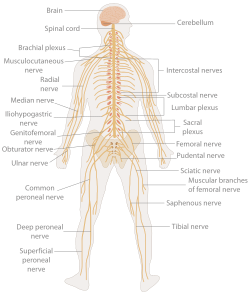| Organ system | Description | Component organs |
|---|
| Respiratory system | breathing: exchange of oxygen and carbon dioxide | nose, mouth, paranasal sinuses, pharynx, larynx, trachea, bronchi, lungs and thoracic diaphragm |
| Digestive and excretory system | digestion: breakdown and absorption of nutrients, excretion of solid wastes | teeth, tongue, salivary glands, esophagus, stomach, liver, gallbladder, pancreas, small intestine, large intestine, rectum and anus |
| Circulatory system | circulate blood in order to transport nutrients, waste, hormones, O2, CO2, and aid in maintaining pH and temperature | blood, heart, arteries, veins and capillaries |
| Urinary system | maintain fluid and electrolyte balance, purify blood and excrete liquid waste (urine) | kidneys, ureters, bladder and urethra |
| Integumentary system | exterior protection of body and thermal regulation | skin, hair, fat and nails |
| Skeletal system | structural support and protection, production of blood cells | bones, cartilage, ligaments and tendons |
| Muscular system | movement of body, production of heat | skeletal muscles, smooth muscles and cardiac muscle |
| Endocrine system | communication within the body using hormones made by endocrine glands | hypothalamus, pituitary, pineal gland, thyroid, parathyroid and adrenal glands, ovaries and testicles |
| Exocrine system | various functions including lubrication and protection | ceruminous glands, lacrimal glands, sebaceous glands and mucus |
| Lymphatic system | return lymph to the bloodstream, aid immune responses, form white blood cells | lymph, lymph nodes, lymph vessels, tonsils, spleen and thymus |
| Nervous system | sensing and processing information, controlling body activities | brain, spinal cord, nerves, sensory organs and the following sensory systems (nervous subsystems): visual system,smell (olfactory system), taste (gustatory system) and hearing (auditory system) |
| Reproductive system | sex organs involved in reproduction | ovaries, fallopian tubes, uterus, vagina, vulva, penis, testicles, vasa deferentia, seminal vesicles and prostate |

